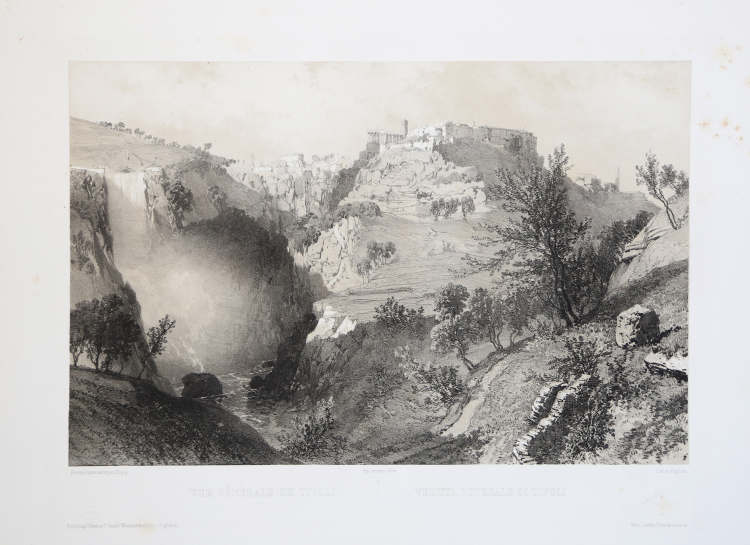


| Reference: | S4022 |
| Author | Eugene CICERI |
| Year: | 1820 ca. |
| Zone: | Tivoli |
| Printed: | Paris |
| Measures: | 425 x 320 mm |


| Reference: | S4022 |
| Author | Eugene CICERI |
| Year: | 1820 ca. |
| Zone: | Tivoli |
| Printed: | Paris |
| Measures: | 425 x 320 mm |
Bella e pittoresca veduta litografica eseguita da Eugene Ciceri su soggetto di Chapuy, e stampata da Lemercier.
Litografia tinta, in ottimo stato di conservazione. Rara
Eugene CICERI (Parigi 1813 - Fontainebleau 1890)
|
French painter and lithographer. After training with his father Pierre-Luc-Charles Ciceri (1782–1868), the scene designer for the Opéra in Paris, he decorated the theatre at Le Mans in 1842 under his influence. He was, however, mainly known as a landscape painter and first exhibited at the Salon in 1851. He painted Landscape (1850; Blois, Mus. Mun.), which was executed in the style of Corot and such Barbizon artists as Charles-François Daubigny, Jules Dupré, Paul Huet and Narcisse Diaz, whose fluffy brushstroke and buttery impasto he adopted. He worked at Barbizon (at the spot known as ‘La Belle Marie’) and also around Fontainebleau, the Seine and the Marne, where he produced a beautiful view of the Banks of the Marne (1869; Chalon-sur-Saône, Mus. Denon). He also painted several landscapes of Paris, among them a View of the Moulin de la Galette in Montmartre (undated; Paris, Carnavalet). As a lithographer he sometimes worked in collaboration with Alfred Dedreux and from 1835 helped to illustrate Voyages pittoresques et romantiques dans l’ancienne France (24 vols, Paris, 1820–78), written by Isidore-Justin-Séverin Taylor, Charles Nodier and Alphonse de Cailleux, in particular the volume devoted to Brittany in 1845. He also illustrated Souvenirs d’Egypte (Paris, 1851), by Alexandre Bida and E. Bardot, and Victor Fournel’s Paris et ses ruines en mai 1871 (Paris, 1871).
|
Eugene CICERI (Parigi 1813 - Fontainebleau 1890)
|
French painter and lithographer. After training with his father Pierre-Luc-Charles Ciceri (1782–1868), the scene designer for the Opéra in Paris, he decorated the theatre at Le Mans in 1842 under his influence. He was, however, mainly known as a landscape painter and first exhibited at the Salon in 1851. He painted Landscape (1850; Blois, Mus. Mun.), which was executed in the style of Corot and such Barbizon artists as Charles-François Daubigny, Jules Dupré, Paul Huet and Narcisse Diaz, whose fluffy brushstroke and buttery impasto he adopted. He worked at Barbizon (at the spot known as ‘La Belle Marie’) and also around Fontainebleau, the Seine and the Marne, where he produced a beautiful view of the Banks of the Marne (1869; Chalon-sur-Saône, Mus. Denon). He also painted several landscapes of Paris, among them a View of the Moulin de la Galette in Montmartre (undated; Paris, Carnavalet). As a lithographer he sometimes worked in collaboration with Alfred Dedreux and from 1835 helped to illustrate Voyages pittoresques et romantiques dans l’ancienne France (24 vols, Paris, 1820–78), written by Isidore-Justin-Séverin Taylor, Charles Nodier and Alphonse de Cailleux, in particular the volume devoted to Brittany in 1845. He also illustrated Souvenirs d’Egypte (Paris, 1851), by Alexandre Bida and E. Bardot, and Victor Fournel’s Paris et ses ruines en mai 1871 (Paris, 1871).
|